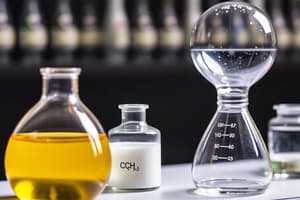Podcast
Questions and Answers
Where are metals generally located on the periodic table, relative to the 'invisible staircase'?
Where are metals generally located on the periodic table, relative to the 'invisible staircase'?
- To the right and above the staircase.
- To the left of the staircase. (correct)
- To the right and below the staircase.
- Along the staircase.
Which of the following is NOT a typical physical property of metals?
Which of the following is NOT a typical physical property of metals?
- Malleable and ductile.
- Good conductors of electricity.
- Dull appearance. (correct)
- High melting points.
How does a compound differ from a mixture?
How does a compound differ from a mixture?
- A compound is always homogeneous, while a mixture is always heterogeneous.
- A compound retains the properties of its constituent elements, while a mixture forms new properties.
- A compound can be easily separated into its constituents by physical means, while a mixture cannot.
- A compound consists of elements chemically bonded in a fixed ratio, while a mixture involves elements or compounds physically combined without a fixed ratio. (correct)
Which particle diagram BEST represents a pure compound?
Which particle diagram BEST represents a pure compound?
Which separation technique is MOST suitable for separating a mixture of salt and sand?
Which separation technique is MOST suitable for separating a mixture of salt and sand?
What is the correct name for the compound with the formula $N_2O_5$?
What is the correct name for the compound with the formula $N_2O_5$?
Which gas makes up the largest percentage of Earth's atmosphere today?
Which gas makes up the largest percentage of Earth's atmosphere today?
How can the purity of a water sample be tested using the boiling point test?
How can the purity of a water sample be tested using the boiling point test?
Which of the following statements about the early Earth's atmosphere is MOST accurate?
Which of the following statements about the early Earth's atmosphere is MOST accurate?
A substance is found to have a definite chemical formula and can only be broken down into simpler substances through chemical reactions. Which of the following BEST describes this substance?
A substance is found to have a definite chemical formula and can only be broken down into simpler substances through chemical reactions. Which of the following BEST describes this substance?
Which of these options correctly describes a method for separating iron filings from a mixture of iron filings and sulfur?
Which of these options correctly describes a method for separating iron filings from a mixture of iron filings and sulfur?
What is the correct name for the compound formed between aluminum ($Al$) and oxygen ($O$)?
What is the correct name for the compound formed between aluminum ($Al$) and oxygen ($O$)?
How did the composition of Earth's atmosphere change from its early state to its current state?
How did the composition of Earth's atmosphere change from its early state to its current state?
Consider a solution that is supposed to be pure water. It boils at $100.5°C$ at standard atmospheric pressure. What does this indicate about the solution?
Consider a solution that is supposed to be pure water. It boils at $100.5°C$ at standard atmospheric pressure. What does this indicate about the solution?
Which of the following is a compound?
Which of the following is a compound?
Given a particle diagram showing two different types of molecules mixed together, what does this diagram represent?
Given a particle diagram showing two different types of molecules mixed together, what does this diagram represent?
Which technique would be MOST appropriate for separating a mixture of two liquids with different boiling points?
Which technique would be MOST appropriate for separating a mixture of two liquids with different boiling points?
What is the name of the molecule with the formula $CCl_4$?
What is the name of the molecule with the formula $CCl_4$?
What process was primarily responsible for the increase in oxygen levels in Earth's early atmosphere?
What process was primarily responsible for the increase in oxygen levels in Earth's early atmosphere?
A student tests the boiling point of a liquid and finds it boils constantly at $78.3°C$. What can be concluded about this liquid?
A student tests the boiling point of a liquid and finds it boils constantly at $78.3°C$. What can be concluded about this liquid?
Flashcards
Periodic Table
Periodic Table
A chart organizing elements by their atomic number and chemical properties.
Metal vs Non-metal Location
Metal vs Non-metal Location
Metals are on the left, non-metals on the right, divided by a line resembling a staircase.
Metals (properties)
Metals (properties)
Typically shiny, conductive, malleable, and tend to lose electrons in chemical reactions.
Mixture
Mixture
Signup and view all the flashcards
Compound
Compound
Signup and view all the flashcards
Particle diagrams
Particle diagrams
Signup and view all the flashcards
Separating Mixtures
Separating Mixtures
Signup and view all the flashcards
Naming Compounds
Naming Compounds
Signup and view all the flashcards
Composition of Air
Composition of Air
Signup and view all the flashcards
Purity Test
Purity Test
Signup and view all the flashcards
Study Notes
- Elements are organized in a periodic table.
- Metals are on the left of the "invisible staircase" on the periodic table while non-metals are on the right.
- Mixtures and compounds have distinct definitions.
- Particle diagrams can represent mixtures, compounds, and molecules, and you should be able to draw and identify each type.
- There are multiple methods available to separate a mixture.
- Compounds and molecules can be named systematically.
- Air has a specific composition and the Earth's atmosphere has evolved to its present state.
- The boiling point test can determine the purity of a solution.
Studying That Suits You
Use AI to generate personalized quizzes and flashcards to suit your learning preferences.




